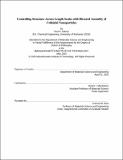| dc.contributor.advisor | .Robert J. Macfarlane | en_US |
| dc.contributor.author | Gabrys, Paul A.(Paul Anthony) | en_US |
| dc.contributor.other | Massachusetts Institute of Technology. Department of Materials Science and Engineering. | en_US |
| dc.date.accessioned | 2020-10-08T21:29:15Z | |
| dc.date.available | 2020-10-08T21:29:15Z | |
| dc.date.copyright | 2020 | en_US |
| dc.date.issued | 2020 | en_US |
| dc.identifier.uri | https://hdl.handle.net/1721.1/127895 | |
| dc.description | Thesis: Ph. D., Massachusetts Institute of Technology, Department of Materials Science and Engineering, May, 2020 | en_US |
| dc.description | Cataloged from the official PDF of thesis. | en_US |
| dc.description | Includes bibliographical references (pages 319-334). | en_US |
| dc.description.abstract | One of the promises of nanotechnology is the ability to create a bulk, designer material with its structure programmed at each length scale using deterministic control over the placement of each nanoscale component. Self-assembled nanoparticle colloids, particularly those directed by sequence-specific DNA hybridizations, have emerged as a promising building block for producing these designer materials from nanoparticles that arrange themselves into precise symmetries through mechanisms analogous to atomic crystallization. However, DNA-directed colloids and other self-assembled nanoparticle systems still struggle to realize the goal of arbitrary structure control at length scales larger than a few microns due to the complexity of forces impacting different scales simultaneously. | en_US |
| dc.description.abstract | Utilizing existing atomic analogues for inspiration, this work extends the structure-defining nature of these programmable building blocks by imposing lithographic boundary conditions and devising processing techniques resembling those of atomic thin films and powders. Crystallization at an interface is explored, and preferential grain growth from a substrate is demonstrated to control large scale crystal texture. Full crystal orientation control is achieved by using standard nano-fabrication techniques to construct a lithographically-defined template for epitaxial growth that can define arbitrary macroscale shapes over millimeters. The resulting crystallization platform exhibits remarkable resiliency to lattice mismatch due to the 'soft' nature of the DNA ligands binding nanoparticles together. The understanding garnered from the DNA-grafted nanoparticle as a model system is extended to a colloid synthesized from a more scalable and robust directing polymer, polystyrene. | en_US |
| dc.description.abstract | The unique advantages of this new building block enable the fabrication of truly bulk, 3D materials with arbitrary macroscale shape on the centimeter scale via sintering and post-processing of nanoparticle-based crystallites. The results of this work are nanoparticle-based materials with dictated structure from the nanoscale (crystallographic unit cell), through the microscale (crystallite size and orientation), to the macroscale (lithographically defined shape). | en_US |
| dc.description.statementofresponsibility | by Paul A. Gabrys. | en_US |
| dc.format.extent | 334 pages | en_US |
| dc.language.iso | eng | en_US |
| dc.publisher | Massachusetts Institute of Technology | en_US |
| dc.rights | MIT theses may be protected by copyright. Please reuse MIT thesis content according to the MIT Libraries Permissions Policy, which is available through the URL provided. | en_US |
| dc.rights.uri | http://dspace.mit.edu/handle/1721.1/7582 | en_US |
| dc.subject | Materials Science and Engineering. | en_US |
| dc.title | Controlling structure across length scales with directed assembly of colloidal nanoparticles | en_US |
| dc.type | Thesis | en_US |
| dc.description.degree | Ph. D. | en_US |
| dc.contributor.department | Massachusetts Institute of Technology. Department of Materials Science and Engineering | en_US |
| dc.identifier.oclc | 1197625778 | en_US |
| dc.description.collection | Ph.D. Massachusetts Institute of Technology, Department of Materials Science and Engineering | en_US |
| dspace.imported | 2020-10-08T21:29:14Z | en_US |
| mit.thesis.degree | Doctoral | en_US |
| mit.thesis.department | MatSci | en_US |
